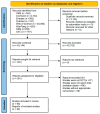Optimal Non-Pharmacological Interventions for Reducing Problematic Internet Use in Youth: A Systematic Review and Bayesian Network Meta-Analysis
- PMID: 39851902
- PMCID: PMC11762159
- DOI: 10.3390/bs15010098
Optimal Non-Pharmacological Interventions for Reducing Problematic Internet Use in Youth: A Systematic Review and Bayesian Network Meta-Analysis
Abstract
The purpose of this network meta-analysis (NMA) is to compare the effect of different non-pharmacological interventions (NPIs) on Problematic Internet Use (PIU). Randomized controlled trials (RCTs) published from their inception to 22 December 2023 were searched in Cochrane Central Register of Controlled Trials, Embase, Medline, Web of Science, China National Knowledge Infrastructure, China Science and Technology Journal Database, Chinese BioMedical Literature Database, and WanFang Data. We carried out a data analysis to compare the efficacy of various NPIs using Bayesian NMA. A battery of analyses and assessments, such as conventional meta-analysis and risk of bias, were performed concurrently. Two reviewers extracted data and evaluated bias using the Cochrane Risk of Bias tool independently. We identified 90 RCTs including 15 different NPIs (5986 participants), namely sports intervention (SI), electroencephalogram biological feedback (EBF), reality therapy (RT), positive psychology therapy (PPT), sandplay therapy (ST), educational intervention (EI), compound psychotherapy (CPT), electroacupuncture therapy (AT), group counseling (GC), family therapy (FT), electrotherapy (ELT), craving behavior intervention (CBI), virtual reality therapy (VRT), cognitive behavior therapy (CBT), and mindfulness therapy (MT). Our NMA results showed that SI, EBF, RT, PPT, ST, EI, CPT, AT, GC, FT, ELT, CBT, CBI, VRT, and MT were effective in reducing PIU levels. The most effective NPI was SI (SMD = -4.66, CrI: -5.51, -3.82, SUCRA = 95.43%), followed by EBF (SMD = -4.51, CrI: -6.62, -2.39, SUCRA = 90.89%) and RT (SMD = -3.83, CrI: -6.01, -1.62, SUCRA = 81.90%). Our study showed that SI was the best NPI to relieve PIU levels in youth. Medical staff should be aware of the application of SI to the treatment of PIU in youth in future clinical care.
Keywords: internet addiction; network meta-analysis; non-pharmacological interventions; problematic internet use; youth.
Conflict of interest statement
The authors declare no conflicts of interest.
Figures




Similar articles
-
Effects of non-pharmacological interventions on youth with internet addiction: a systematic review and meta-analysis of randomized controlled trials.Front Psychiatry. 2024 Jan 11;14:1327200. doi: 10.3389/fpsyt.2023.1327200. eCollection 2023. Front Psychiatry. 2024. PMID: 38274427 Free PMC article. Review.
-
Effectiveness comparisons of various psychosocial therapies for cancer-related fatigue: A Bayesian network meta-analysis.J Affect Disord. 2022 Jul 15;309:471-481. doi: 10.1016/j.jad.2022.04.152. Epub 2022 Apr 30. J Affect Disord. 2022. PMID: 35504400 Review.
-
Effects of non-pharmacological interventions on depressive and anxiety symptoms in pregnant women: a systematic review and network meta-analysis.EClinicalMedicine. 2024 Dec 18;79:103011. doi: 10.1016/j.eclinm.2024.103011. eCollection 2025 Jan. EClinicalMedicine. 2024. PMID: 39802308 Free PMC article.
-
Comparative efficacy of seven Chinese patent medicines for early diabetic kidney disease: A Bayesian network meta-analysis.Complement Ther Med. 2022 Aug;67:102831. doi: 10.1016/j.ctim.2022.102831. Epub 2022 Apr 7. Complement Ther Med. 2022. PMID: 35398481 Review.
-
Comparing the effectiveness of mind-body practices (MBPs) and various psychological methods on occupational stress among healthcare workers: a network meta-analysis of randomized controlled trials.BMC Health Serv Res. 2024 Aug 21;24(1):962. doi: 10.1186/s12913-024-11437-7. BMC Health Serv Res. 2024. PMID: 39169332 Free PMC article.
References
-
- Adalıer A., Balkan E. The relationship between internet addiction and psychological symptoms. International Journal of Global Education (IJGE) 2012;1(2):45–48.
-
- Banerjee S., Hellier J., Dewey M., Romeo R., Ballard C., Baldwin R., Bentham P., Fox C., Holmes C., Katona C., Knapp M., Lawton C., Lindesay J., Livingston G., McCrae N., Moniz-Cook E., Murray J., Nurock S., Orrell M., Burns A. Sertraline or mirtazapine for depression in dementia (HTA-SADD): A randomised, multicentre, double-blind, placebo-controlled trial. Lancet. 2011;378(9789):403–411. doi: 10.1016/S0140-6736(11)60830-1. - DOI - PubMed
-
- Bastioli G., Arnold J. C., Mancini M., Mar A. C., Gamallo-Lana B., Saadipour K., Chao M. V., Rice M. E. Voluntary exercise boosts striatal dopamine release: Evidence for the necessary and sufficient role of BDNF. Journal of Neuroscience. 2022;42(23):4725–4736. doi: 10.1523/JNEUROSCI.2273-21.2022. - DOI - PMC - PubMed
-
- Burton J. K., Craig L. E., Yong S. Q., Siddiqi N., Teale E. A., Woodhouse R., Barugh A. J., Shepherd A. M., Brunton A., Freeman S. C., Sutton A. J., Quinn T. J. Non-pharmacological interventions for preventing delirium in hospitalised non-ICU patients. Cochrane Database of Systematic Reviews. 2021;11(11):CD013307. doi: 10.1002/14651858.CD013307. - DOI - PMC - PubMed
Publication types
LinkOut - more resources
Full Text Sources
Miscellaneous

